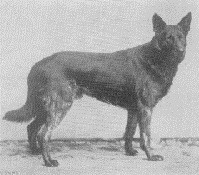The German Shepherd Dog breed began creation in the 1800s northwest Europe Belgium,
Germany, Netherlands the most common dog used to herd sheep and protect the homes was
the so called "continental shepherd dog". These dogs all looked very
similar at that time, and it was around 1890 that the three breeds
|
| Other names: |
- Alsatian
- Berger Allemand
- Deutscher Schäferhund
- Schäferhund
|
|
| Common nicknames: |
|
|
| Origin: |
Germany |
|
| Weight: |
Male: |
30–40 kg (66–88 lb) |
|
Female: |
22–32 kg (49–71 lb) |
| Height: |
Male: |
60–65 cm (24–26 in) |
|
Female: |
55–60 cm (22–24 in) |
| Coat: |
Double coat |
| Colour: |
Most commonly tan with |
|
black saddlery |
| Litter size: |
4 – 9 puppies |
| Life span: |
9 – 13 years |
Belgian Shepherd, German Shepherd and Dutch Shepherd went their separate
ways. Of those breeds, the Dutch shepherd looks closest to the
continental shepherd of that time. During the 1850s, attempts
were being made to standardize dog breeds. Dogs were being bred
to preserve traits that assisted in their job of herding sheep
and protecting their flocks from predators. In Germany this was
practiced within local communities, where shepherds selected and
bred dogs. It was recognized that the breed had the necessary
skills for herding sheep, such as intelligence, speed, strength
and keen senses of smell. The results were dogs that were able
to do such things, but that differed significantly, both in
appearance and ability, from one locality to another. To combat
these differences, the Phylax Society was formed in 1891 with
the intention of creating standardised development plans for
native dog breeds in Germany. The society disbanded after only
three years due to on-going internal conflicts regarding the
traits in dogs that the society should promote; some members
believed dogs should be bred solely for working purposes, while
others believed dogs should be bred also for appearance. While
unsuccessful in their goal, the Phylax Society had inspired
people to pursue standardising dog breeds independently. With
the rise of large, industrialized cities in Germany, the
predator population began to decline, rendering sheepdogs
unnecessary. At the same time, the awareness of sheepdogs as a
versatile, intelligent class of canine began to rise. Max von
Stephanitz, an ex-cavalry captain and former student of the
Berlin Veterinary College, was an ex-member of the Phylax
Society who firmly believed dogs should be bred for working. He
admired the intelligence, strength and ability of Germany's
native sheepdogs, but could not find any one single breed that
satisfied him as the perfect working dog. In 1899, Von
Stephanitz was attending a dog show when he was shown a dog
named Hektor Linksrhein. Hektor was the product of few
 |
| Beowulf |
generations of selective breeding and completely fulfilled what
Von Stephanitz believed a working dog should be. He was pleased
with the strength of the dog and was so taken by the animal's
intelligence, loyalty and beauty, that he purchased him
immediately. After purchasing the dog he changed his name to
Horand von Grafrath and Von Stephanitz founded the Verein für
Deutsche Schäferhunde (Society for the German Shepherd Dog).
Horand was declared to be the first German Shepherd Dog and was
the first dog added to the society's breed register. Horand
became the centre-point of the breeding programs and was bred with
dogs belonging to other society members that displayed desirable
traits and with dogs from Thuringia, Franconia and Wurttemberg.
Fathering many pups, Horand's most successful was Hektor von Schwaben.
Hektor was inbred with another of Horand's offspring and produced
Heinz von Starkenburg Beowulf and Pilot, who later fathered a
total of eighty-four pups, mostly through being
inbred with Hektor's other offspring. This inbreeding was deemed
necessary in order to fix the traits being sought in the breed.
In the original German Shepherd studbook, Zuchtbuch für Deutsche
Schäferhunde (SZ), within the two pages of entries from SZ No.
41 to SZ No. 76, there are four Wolf Crosses. Beowulf's progeny
also were inbred and it is from these pups that all German
Shepherds draw a genetic link. It is believed the society
accomplished its goal mostly due to Von Stephanitz's strong,
uncompromising leadership and he is therefore credited with
being the creator of the German Shepherd Dog.








